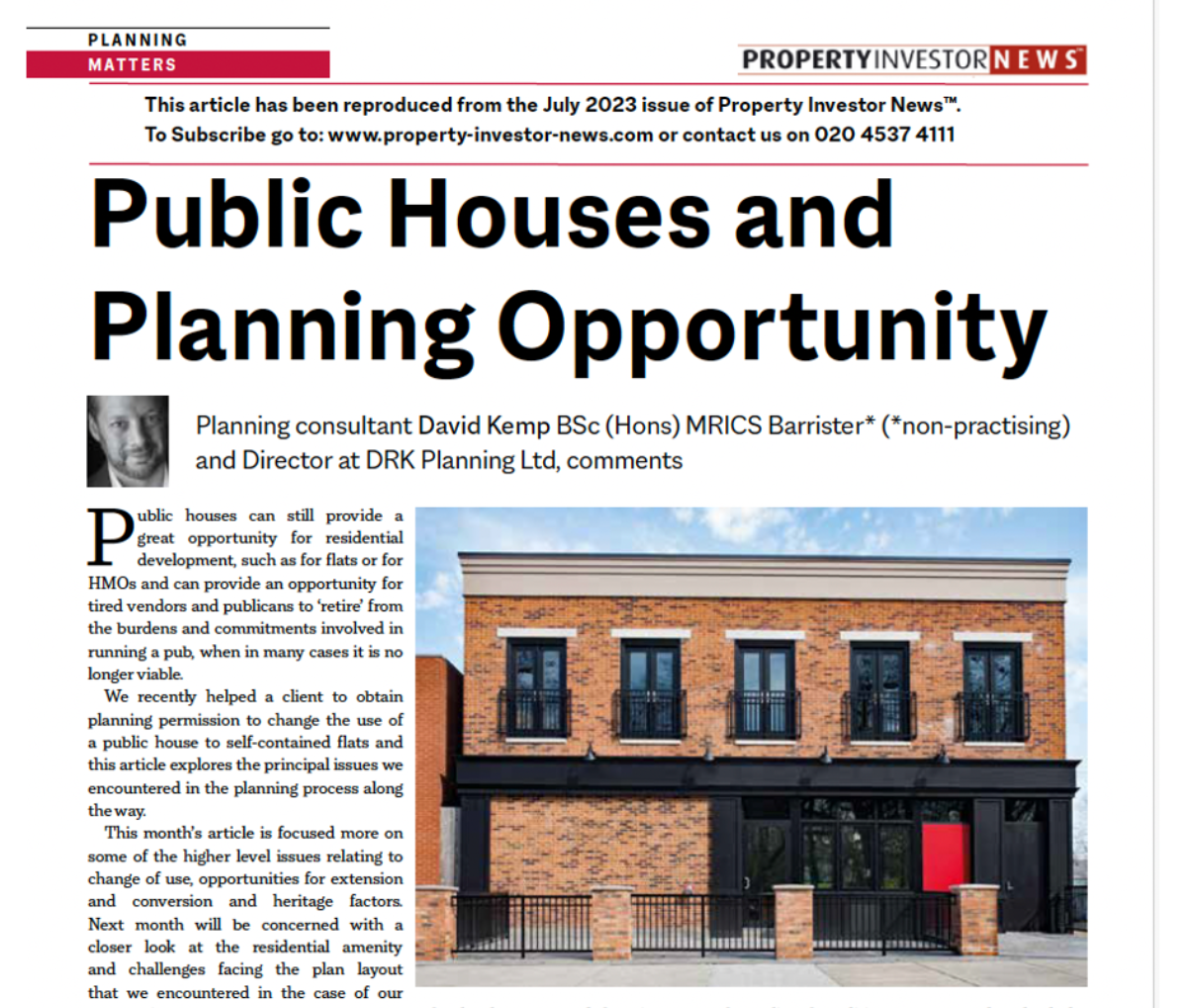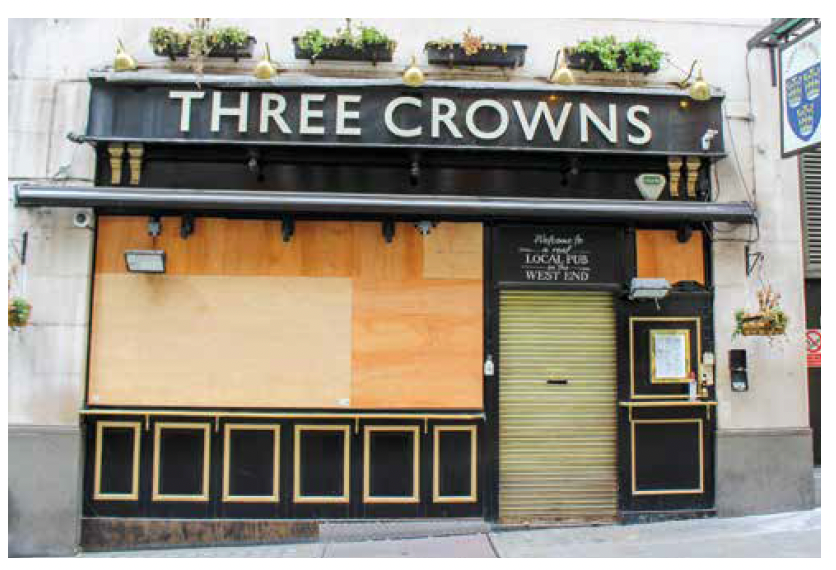
Public houses can still provide a great opportunity for residential development, such as for flats or for HMOs and can provide an opportunity for tired vendors and publicans to ‘retire’ from the burdens and commitments involved in running a pub, when in many cases it is no longer viable.
We recently helped a client to obtain planning permission to change the use of a public house to self-contained flats and this article explores the principal issues we encountered in the planning process along the way.
This month’s article is focused more on some of the higher-level issues relating to change of use, opportunities for extension and conversion and heritage factors. Next month will be concerned with a closer look at the residential amenity and challenges facing the plan layout that we encountered in the case of our recent win.
Lack of viability in pub operation
The starting point for all proposals for the change of use of pubs will be the policies of the Local Plan. This document might specifically address the loss of pubs or might engage this more generally with regard to ‘community uses’. Public houses fall within ‘sui generis’ use; a ‘miscellaneous’ planning class where planning permission is required for any movement in and out of that particular use and there are no PD rights.
The local plan approach toward ‘community use’ is mostly a reflection of the typical function and local contribution that such premises have tended to make, providing a focal social point, space for sporting and leisure pursuits (e.g. pub darts, snooker or quiz teams), live music and events, meeting space for local groups and function space for occasions, depending on the particular amenities of the pub or character of the local community.
Therefore, in viewing any pub opportunity, understanding how this pub might have contributed locally, will help to form a strategy for whether it can be replaced with a residential scheme.
The Council in our recent case needed to have regard to the following factors:
- Is there alternative local provision?
- Has an alternative community use of the premises been explored?
- Is there the possibility of providing alternative community facilities elsewhere?
The text under the main policy wording or supplementary documents might explain further and set out specific conditions or requirements to these policy tests. Other local authorities might have a different list of conditions, so you need to check the policies relevant to the area in which your property is based.
Campaign and pressure groups, such as CAMRA (the Campaign for Real Ale) have also produced their own ‘viability test’ to assist local authorities; e.g. https://camra.org.uk/campaign_resources/public-house-viability-test/. However, such groups are not statutory consultees, these tests do not have the force of local plan policy and cannot substitute local plan policy (unless expressly a part of the policy), and will generally carry little to moderate weight in planning decision-making.
Evidence-based approach
When looking at such opportunities, the developer may have to come to their own view as to whether there is a good prospect of changing the use of the property to residential use.
In our case, the available sources of evidence included the following:
- Check on Google of other pubs within 1 mile.
- Look at accounts for last 3-5 years (if available) – declining sales and profit?
- Active marketing exercise and period of vacancy
- Condition of the building and likely cost to bring it back into a viable use
It may be necessary to dig a bit deeper to see if the other pubs nearby offer a similar service or similar amenities to the local community.
When presenting accounts in the application to the Council, remember you are dealing with planning officers – not company auditors or accountants! Keep it simple by also including a table that simply summarises ‘total sales’ each year vs ‘total profit (or losses)’ each year. It is also important to try to explain the reasons for this decline in trade; the vendor or their agent pre-purchase might be able to explain this and put it into context. It is important to understand that the reasons for the declining demand are matters that are beyond the control of the business and would not simply be ‘cured’ by different management, a different pub ‘concept’ (e.g. gastropub or more food offer), or expanded social activities.
Agents can be a good source of supporting evidence to explain these threats and weaknesses to the business, especially if the agent is a leisure and pub specialist (e.g. Fleurets). Typical factors might include:
- Increasing preference among younger generation for bars, clubs and restaurants to socialise and drink alcohol.
- Changes in licensing laws and consumption of alcohol at home instead (e.g. with takeaway with friends).
- Change in attitudes of some towards crowded and enclosed social spaces since the Pandemic.
It is usually prudent to insist on a condition in the sale that, after purchase, the vendor and their agents will afford all reasonable help and assistance in providing information and evidence to support the planning application.
Testing the ‘political temperature’ and agreeing options
If there is insufficient time to speak with the Council’s officers, the local ‘temperature’ could be tested by enquiring with local Ward Councillors, as they might often be more candid and can sometimes provide an insight into the prospect of local support or concern at an early stage. Forewarned is forearmed!
Even if local councillors and others might indicate resistance to the prospect of a change of use, this might not necessarily be fatal to an application. Developers should still go through the process of taking the ‘evidence-based’ approach above. Feedback from local councillors and others might just give the developer a sense of possible ‘political’ resistance and the prospect of a ‘politicised’ refusal and need to go to planning appeal. This can be particularly useful if the deal can be structured on a conditional basis or seeking to agree an Option with the vendor (e.g. subject to planning), as this can help to inform the time it will take to get planning, and the possible length of the Option and provisions to extend it.
Assets of Community Value
The pub conversion in this case was not on a local ACV register. If it had been, then it would have had to be offered for sale first to local groups interested in buying it to retain it as a pub. However, there is no legal requirement to agree to sell to such interests and there is no power to force a sale.
The advice of a property solicitor should be sought on ensuring that any sale complies with the conditions imposed by the law where a property is an ACV. In terms of planning, it merely flags up the fact that there is likely to be considerable local interest, or even resistance to the prospect of residential development.
‘Heritage’ assets and loss of public house use
Many pubs are either listed buildings or they might be within a conservation area. Whether or not that means that the pub is locally or nationally listed, many of the conservation principles are similar and will require a consideration of the pub’s preservation as a pub, rather than in residential use.
Listed buildings
Listed buildings fall into 3 main categories: Grade I, Grade II* and Grade II, in order of importance in heritage terms from the best (and rarest) to the most prevalent and lesser (but still important!).
It is important to remember that when a building is ‘listed’, then the following applies:
The listing protects the interior as well as the exterior.
The setting around the property (e.g. open spaces, gardens and ancillary structures) might be important and might have to be retained as open space.
There may be an opportunity to develop on extended ‘garden’ land to the rear of the pub or car park land, but the contribution made by this land to the character of the listed building needs to be carefully considered.
Ancillary structures may need to be retained as these might also be covered by the listing – known as ‘curtilage listed’ as they are physically and functionally connected to the use of the pub historically (e.g. storehouses, water pumps).
It is especially important in considering the potential of such buildings to bring in early not only a Planning Consultant but also:
Heritage Consultant: they can advise on where room layouts might possibly be changed and where certain walls, features or structures have to be retained. This helps to create a set of ‘safe’ assumptions for the architect to prepare drawings.
Builder: ensure that the builder is not only local but also has a track record in dealing with specialist listed buildings, often timber frame construction. They will need to view the property (ideally with the Heritage and Planning Consultant) so they can provide a clear steer as to the likely costs involved with a realistic scheme.
Locally listed buildings
Some buildings are important for their local historic or architectural merit and there are a lot of pubs that are not listed at a national level, but are regarded as making an important local contribution.
The Council might retain a ‘local list’ or it may have other, non-statutory local heritage categories, such as ‘Building of Merit’, a building that ‘makes a positive contribution’ to the local area (especially a conservation area), or other similar phrase.
Your planning consultant should advise you whether the pub is ‘noted’ or ‘listed’. It is not as necessary to bring in a Heritage Consultant for such buildings. However, the preference is usually to try to retain as much as possible of the current exterior and keep all changes to the interior. Unlike nationally listed buildings, the interior is not protected to the same degree and more can be done with existing internal walls, doors, features, floors and ceilings, even if it is original fabric.
In a few of these cases, if the building has been ‘locally listed’ mostly due to the contribution made by the façade to the character and appearance of the area or street scene, it may be possible to wholly demolish the building, whilst retaining the façade in place, and develop and extend (upwards and backwards) behind the façade in a way that would not conflict with heritage policy.
Other opportunities
Where a building is locally listed, there is generally greater scope for adding and removing buildings in the curtilage, as well as altering roof forms (e.g. to mansard roofs or installing dormer windows and roof lights).
Basements and beer cellars can create a further opportunity for additional dwellings or habitable rooms, subject to internal finished floor to ceiling heights, sunlight and daylight and ventilation.
Lastly, many pubs also already provide residential accommodation on the upper floors, which could either be retained, re-planned as part of a redevelopment or conversion of the site, or repurposed to an alternative residential use that might compliment the town centre location of the pub, such as for serviced accommodation.

